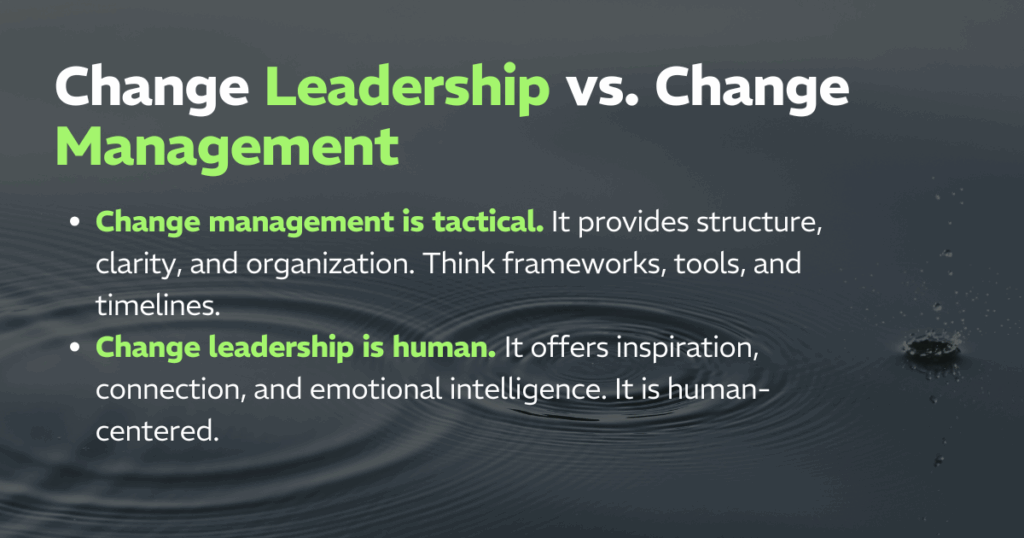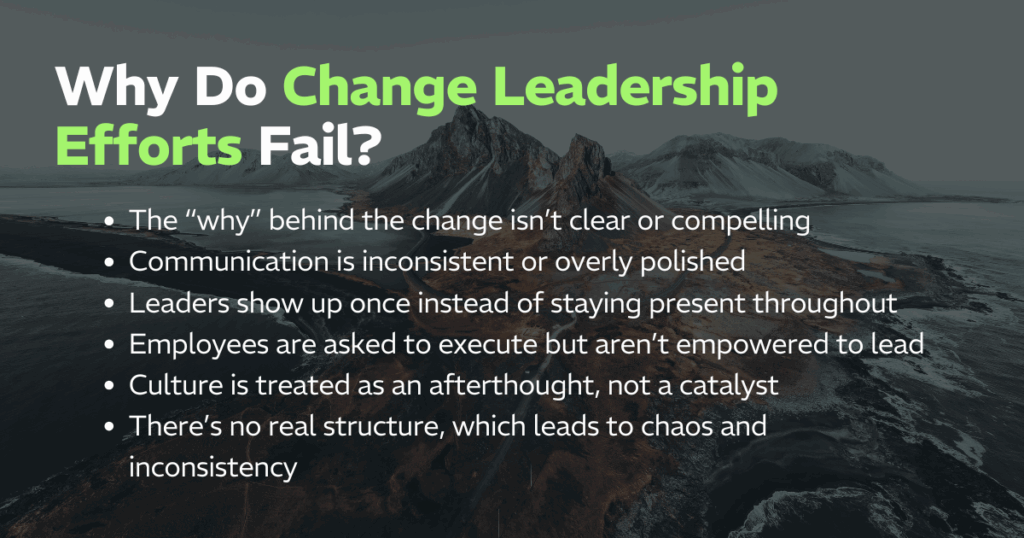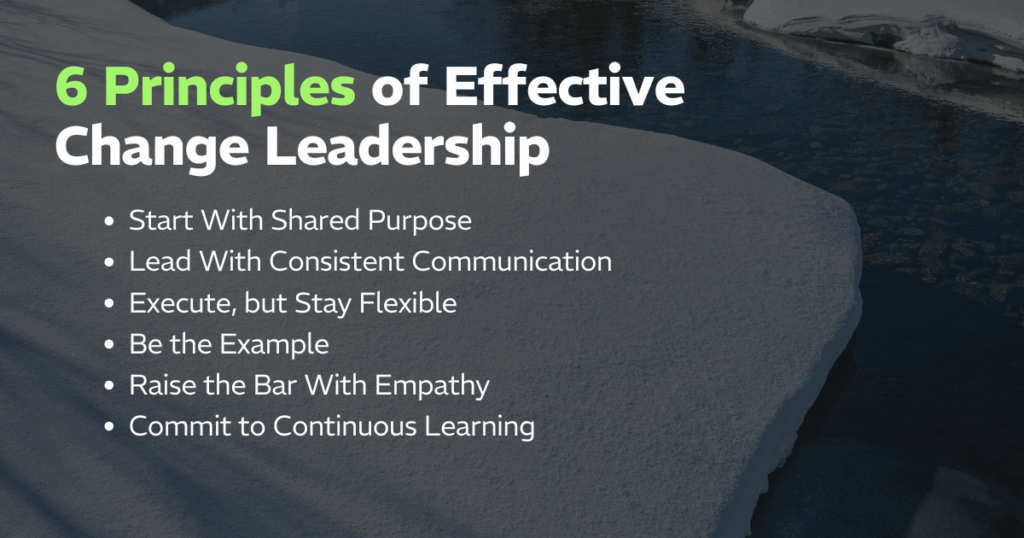Change is hard. Change leadership is even harder.
And the demand for change leadership skills has never been higher. The world is changing rapidly, and companies are investing more and more to disrupt themselves. Accenture’s 2024 “Change Reinvented” report found that 96% of companies will spend at least 5% of revenue on change efforts over the next three years.
Unfortunately, many leaders don’t feel ready for this shift, and neither do their employees. Accenture found that only 30% of executives feel confident in their leadership capabilities, and just 25% think their team members are prepared.
But real change leadership isn’t about having all the answers. It’s about connection. You lead people through change by earning trust, staying present, and making purpose personal. That’s how you move a strategy from the whiteboard to the frontlines.
What Is Change Leadership?
Change leadership is the ability to inspire, guide, and empower people through transformation. It centers on clarity, trust, and human connection—especially during times of disruption.
Change management, by contrast, is about the processes and logistics required to execute change. It involves timelines, management models, communication channels, and strategic planning. Effective change management is important, but it won’t drive lasting change on its own.
Human-centered change leadership adds a vital layer: presence, empathy, and accountability in service of your people. With this mindset, leaders can build trust and foster a culture that’s stronger and more resilient.
Change Leadership vs. Change Management
Change management and leadership are different skills, and the most successful change leaders use both to transform their organizations.
- Change management is tactical. It provides structure, clarity, and organization. Think frameworks, tools, and timelines.
- Change leadership is human. It offers inspiration, connection, and emotional intelligence. It is human-centered.
When we talk about what change leadership is in management, we’re looking to the sweet spot where human connection meets disciplined execution.

Why Do Change Leadership Efforts Fail
Change leadership doesn’t fail because people don’t care. It fails because leaders underestimate what it really takes to move people through disruption.
They mistake communication for connection. They roll out strategy without securing belief. They prioritize process and neglect the people.
We know where it breaks down:
- The “why” behind the change isn’t clear or compelling.
- Communication is inconsistent or overly polished.
- Leaders show up once instead of staying present throughout.
- Employees are asked to execute but aren’t empowered to lead.
- Culture is treated as an afterthought, not a catalyst.
- There’s no real structure, which leads to chaos and inconsistency.
When that happens, even the best strategic plans stall. Not because they were wrong—but because leaders didn’t lead through the hard parts. The messy middle.
That’s where transformation fails—or moves forward. And that’s exactly where human-centered leadership makes the difference.

6 Principles of Effective Change Leadership
When leadership is absent, people fill the silence with fear. That’s when momentum fades. Engagement slips. Your culture cracks.
I’ve seen polished transformation roadmaps never gain traction because teams were instructed, not inspired. Effective change leadership isn’t about controlling outcomes. It’s about connecting people to purpose and empowering employees to act.
Effective change leadership, on the other hand, delivers improved long-term financial performance and a happier, more successful workforce. O.C. Tanner’s 2024 “Embracing Change” report finds that human-centered leadership dramatically improves employees’ change management experiences. These employees are also five times more likely to stay and 78% less likely to suffer burnout.
Here are six human-centered leadership skills to help your organization navigate change effectively:
Start With Shared Purpose
People don’t follow Powerpoints. They follow belief.
They want to understand not just what’s changing, but why it matters and what their role looks like. Connect the dots between the strategic plan and your team’s roles. Translate the vision into personal meaning. That’s how you build buy-in—from the inside out.
Lead With Consistent Communication
You don’t need to have every answer. What you need to do is be present and transparent.
Your communication strategy should create connection, not just compliance. Be visible. Be honest. Make it safe for people to ask questions and voice concerns. Leading through uncertainty requires genuine, consistent communication to reinforce your messages.
Execute, but Stay Flexible
The best plans adapt. So do the best leaders. You can’t control the pace of change, but you can control how you show up—and you can help employees do the same.
Organizational transformations rarely follow a script perfectly. The most effective change leaders understand how to thrive in uncertain times. They’re adaptive emotionally and operationally, allowing them to adjust strategy and modulate their communication in real time.
Set the Right Example
Leaders go first. Just as leaders develop their sales leadership skills by modeling effective behaviors, they also deliver change by setting the example. If you want your organizational culture to promote being accountable, be accountable yourself. If you want them to stay curious, be curious. If you want them to embrace discomfort, go first.
Raise the Bar With Empathy
You can enforce high standards while also supporting your people with empathy.
If someone is falling short, ask questions like, “What’s getting in your way?” Then listen. Show people they don’t have to earn your care. Be clear, compassionate, and accountable to foster resilient, high-performing teams.
Commit to Continuous Learning
Change isn’t a one-time event—it’s ongoing and iterative. The most effective change leaders know that progress requires reflection. They create space to pause, check in, and adapt.
Effective change leadership is a daily practice. Each interaction is an opportunity to reinforce purpose, build trust, and strengthen your team’s readiness for future changes.

Quick Check: Are You Ready to Lead Change?
- Does your team understand the purpose of the change?
- Are you showing up consistently and communicating with transparency?
- Are you modeling the behaviors you expect from your team?
- Are you balancing clear expectations with support?
- Take a moment to reflect—are you ready to lead change effectively?
Daily behaviors build your leadership muscle. The most effective change leaders coach in real time and learn alongside their teams.
3 Change Leadership Examples in Action
To see change leadership in action, we can look at some of the world’s most successful companies. Here are case studies showing what happens when leaders prioritize purpose, presence, and people during times of change.
Microsoft
Over the past decade-plus, Microsoft CEO Satya Nadella has led profound transformations in the company’s products and business model—starting by fostering a culture centered on collaboration and continuous learning. Instead of assuming Microsoft employees have all the answers, Nadella encourages a growth mindset.
“If you take two kids at school, one of them has more innate capability but is a know-it-all,” Nadella told LinkedIn’s Jessi Hempel in 2019. “The other person has less innate capability but is a learn-it-all. The learn-it-all does better than the know-it-all,”
The result? Unrivaled leaps in innovation, from cloud computing with Azure to the company’s in-house AI efforts and partnership with OpenAI. The company’s profits and stock price have followed suit.
IBM
IBM CEO Arvind Krishna has driven change by transforming the culture to focus on what clients and customers need, not just what IBM thinks is best. This required a new vision that focused on “delighting a client in every interaction. Delight them with how technology is deployed,” Krishna told Cloud Wars.
This shift also required a new management strategy. Krishna made the tough decision to spin out non-core business units so IBM could focus on AI and quantum computing.
“You have to be a continuous learning machine,” he told EY. “You’re surrounded by really smart people. Listen to their questions—that makes you learn.”
Amazon
Amazon has embraced an office-first, AI-focused approach to business in recent years. This strategy has generated headlines and resistance among employees. CEO Andy Jassy has acknowledged these concerns while remaining steadfast about what Amazon is trying to accomplish.
He recently shared a candid internal memo signaling an increased emphasis on generative AI across operations—from AWS and Alexa to logistics, inventory, and customer service. Jassy made it clear that this AI-led transformation might even reduce the corporate workforce over the next few years, but emphasized that new roles would emerge for those who adapt
Jassy isn’t pretending this change will be easy. But he’s offering a clear vision for employees to commit to—or choose to go elsewhere.
Why Human-Centered Change Leadership Wins in Times of Change
Successful change management initiatives start with change leadership. Driving transformation is all about human-centered leaders who help their teams bridge the gap between the current state and the new reality waiting on the other side of change.
Great leaders know that it’s not strategic plans that inspire people to change, but inspirational leaders. When you lead with empathy and conviction, people will follow. Think of it not as managing change but rather modeling what leadership through change looks like.
The future doesn’t just need more change. It needs better leaders.
Ready to lead change with empathy, clarity, and confidence? Unlock the mindset and skill set of effective change leadership at Ryan Estis’ Human-Centered Leadership keynote.



![[RYAN] Featured Image - Change Management Skills Winding Architecture](https://ryanestis.com/wp-content/uploads/bb-plugin/cache/RYAN-Featured-Image-Change-Management-Skills-1024x538-panorama-7395bbf10c2a8d43958959443e02cbb1-.png)

![[RYAN] Featured_Leadership Development Planning for Human Centered Growth Group climbing a hill together](https://ryanestis.com/wp-content/uploads/bb-plugin/cache/RYAN-Featured_Leadership-Development-Planning-for-Human-Centered-Growth-1024x538-panorama-ba61edeb5d6c961b544c5c7916ed5ca0-.png)





